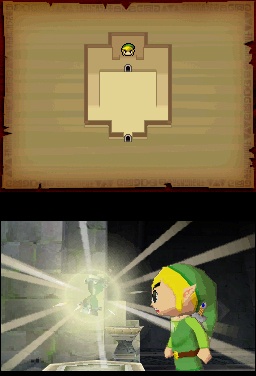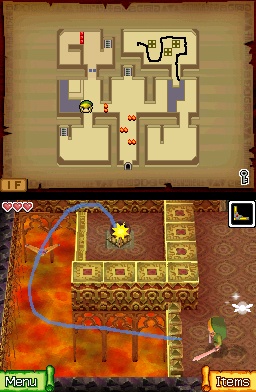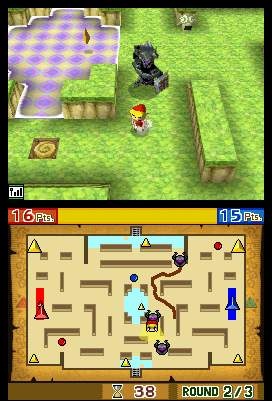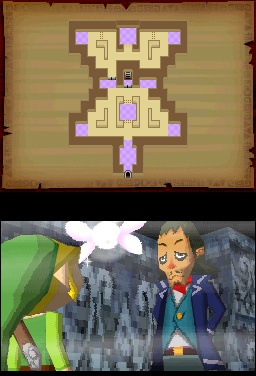It's kind of shocking when you think about it, but despite the Nintendo DS's nearly three-year lifespan, The Legend of Zelda: Phantom Hourglass is the first Zelda game to hit the system. The good news is that it was worth the wait. Phantom Hourglass is essentially a sequel to the GameCube Zelda adventure The Wind Waker. It retains the art style, surrounding world, and plot of that game, but it revamps the mechanics for DS use. The result is a game that is unmistakably Zelda, with its perilous dungeons, tricky puzzles, and engaging boss battles; at the same time, Phantom Hourglass is a unique and innovative entry in the series due largely to its exclusively touch-screen-based control scheme. Everything you do in the game involves taps and swipes of the stylus, from traditional fights and puzzles, to new and specialized functions that really change the way you think about playing a Zelda game.

Phantom Hourglass picks up almost directly where Wind Waker left off. Link is sailing the high seas with his pirate pals, including Tetra, who has forsaken her Zelda namesake and returned to her roguish ways. At the moment, the crew is on the hunt for a fabled ghost ship, one that purportedly contains a great treasure but also has a nasty habit of making people disappear. Of course, the ship magically appears, and Tetra bounds off to search it. Unfortunately, a shrill scream signals that something's gone wrong, and the ghost ship departs into a thicket of fog. Link leaps after it but ends up in the drink, and he eventually washes up on the shore of a populated island. This is how the game explains away the absence of Link's abilities and items, despite the fact that the game takes place just after Wind Waker chronologically.
Upon awakening on the island, you're greeted by an amnesiac fairy who takes you to a kindly old man who explains a thing or two regarding the ghost ship. Though he warns you away from getting into such business, minutes later you've got a sword in your hand and you're learning the basics of combat. Not that there's a ton to learn, mind you. To make a Zelda game on the DS work, the control mechanics have been simplified to rely only on taps and movements via the stylus on the touch screen. Moving Link requires you to simply drag the stylus in the direction you want to go. You tap an enemy to lunge at it with a slash, do a quick swiping movement to execute a broader slash, and draw circles around Link to perform the spin attack. You also have the ability to roll by drawing small circles at the opposite end of the screen. All of this sounds pretty simple and works about as well as you'd hope, apart from a few moments when you may roll in the wrong direction (and off a cliff), or accidentally slash something when you're just trying to turn around. However, most of these small gaffes are relatively harmless, and by and large, the responsiveness of the controls is spot-on.
The game probably wouldn't be very interesting if all you did was run around and tap on bad guys to kill them. Fortunately, there's a great deal more to it than that. Apart from your basic sword combat, you'll also find yourself messing around with some other DS-centric mechanics, like blowing or shouting into the microphone for various reasons. Additionally, you will pick up many of Link's trademark items throughout the game--such as bombs, bombchus (which are little mobile bombs that scurry around), the bow and arrow, the boomerang, and the hookshot--and you'll often have to use them to set up various enemies for the kill. These items behave just as you remember them, though with a number of DS-specific mechanical twists that give them whole new life. For instance, with the boomerang, you can now draw with the stylus the path you want it to take. The same goes for bombchus, who will follow your exact drawn path to any target. The hookshot can be used like normal to help Link leap across open crevices, as a tightrope to walk between two ledges, and as a slingshot to launch Link across wide gaps or repel enemy fire.
These items all tie directly into the game's dungeon and puzzle design. Though not as markedly complex as some of Link's previous adventures, Phantom Hourglass contains several challenging and fun dungeons to traipse through, all of which contain a number of tricky puzzles that require some creative item usage. Experienced Zelda fans may find Phantom Hourglass' dungeons to be less of an endeavor than other games in the series, simply because these dungeons don't rely as heavily on elaborate bouts of backtracking and generally aren't enormous in size. That doesn't mean the dungeons aren't fun to solve, mind you. They might not be quite as epic as other Zelda games, but there are plenty of engaging and periodically perplexing puzzles to solve along the way, as well as some truly exciting boss battles that often make stellar use of both screens on the DS.

Dungeons would probably be even tougher to deal with if it weren't for the fact that you can now write notes and draw pathways on your dungeon maps. It sounds like a small addition at first, but as you play, you'll discover it's actually one of the most revolutionary features in a Zelda game since, well, ever. Simply being able to sketch pathways over invisible platforms and keep a detailed track of which doors you've hit, which switches need to be hit in what order, and the like, is a huge boon and eliminates a lot of aimless wandering from the equation.
Interestingly enough, you get your dungeon and island maps from the very moment you step foot in or on them, though you do have to track down sea charts to open up new areas of the world. Given that this is a Wind Waker sequel, you will be doing a fair amount of sailing from island to island, but unlike Wind Waker, it's not quite as involved a process. You simply draw a route on your map, and the ship sails there automatically. Over time you'll gain a cannon to fight off sea creatures and pirates (and the occasional sea monster boss) as well as a grappling arm to salvage treasure. Picking up treasure is actually a minigame in itself, in that you have to guide the arm down to the depths and back again without hitting mines that are scattered about.
Sailing was the big thing that some folks felt dragged down Wind Waker significantly. It's much easier and less time-consuming here, so that issue is pretty much nonexistent. However, that doesn't mean the game is totally devoid of pacing problems. The main culprit is the Temple of the Ocean King, the very first dungeon you enter, and one that you will have to come back to several times throughout the game. It's not a bad dungeon by itself, and in fact is probably the most overtly challenging of them all due to the fact that the phantoms that walk its halls are invincible and the temple itself will literally suck the life out of you. To make it through, you need to stand in a safe spot or have the Phantom Hourglass handy (an item that protects you for as long as there is sand at the top of the glass).

The problem is that each time you come back, you have to bust through the same levels you beat the previous time around to get to the next section of the temple. Items you acquire later in the game, such as bombs and the hookshot, make getting around a bit easier on subsequent visits, and at the halfway mark of the game, you do get a save point that lets you bypass the first half of the temple and skip down to the second half. Regardless, you'll still be replaying those later levels as the game goes on. It's just one of those tedious things that feel like artificial lengthening of the game more than anything else.
Nevertheless, apart from that one fault, Phantom Hourglass' main quest is a deeply engaging adventure that gives you plenty to do throughout. You can probably finish the quest in about 14-15 hours if you don't hunt around for all the various uncharted islands and sunken treasure chests scattered about the world, but you should, because there's some neat stuff to find.
Once you're done with the game, there is actually a multiplayer mode you can check out. If you ever played Pac-Man vs. on the GameCube (or, more recently, on the DS in Namco Museum DS), this mode might seem slightly familiar to you. One player controls Link, and the opponent has control over several phantoms that can be guided by drawing paths for them with the stylus. Link has to try to collect as many triforce shards as he can and bring them to his base, though he slows down considerably while carrying shards. If a phantom reaches him, his turn is up, but if he reaches a safe zone, the phantoms lose sight of him. This goes back and forth with players taking turns on each side for multiple rounds, and the player with the most shards at the end wins. It's not a spectacular mode by any means, but it's amusing enough as a distraction, and it can be played online against players worldwide. In the few games we tried against mostly Japanese players, performance seemed quite solid, with no noticeable lag.
The graphics, on the other hand, are extremely noticeable. It might be hard to believe that Nintendo would be able to shrink down a game as gorgeous-looking as The Wind Waker, but that's just what it has done here for the DS. Of course, some sacrifices have been made. Character models aren't quite as sharp or colorful, and the world itself isn't nearly as large. But you still inhabit a sizeable world, and everything in it looks spectacular. From the goofy animations and facial expressions of the characters, to the beautiful scenery as you sail around the ocean, this is top-tier work as far as graphics and artistic design on the DS are concerned. One thing to note is that when you're wandering through islands and dungeons, everything is handled with a sort of top-down perspective, not unlike some of the older Zelda games. All the characters and environments are 3D, but the fixed camera angle does a great job of framing the action.

There isn't any voice acting in Phantom Hourglass, but you do get plenty of funny and enjoyable text dialogue to read through. There are lots of memorable characters in the game, and the lack of voice samples isn't much of a hindrance because the expressions on their faces and the great dialogue get the point across. The soundtrack isn't exactly the most memorable of all Zelda scores, but there are plenty of familiar-sounding tunes to accompany each sequence that fans are sure to appreciate.
Ultimately, The Legend of Zelda: Phantom Hourglass is a superb effort and pretty much what you would want from a first entry in the series on the DS. It's got a few pacing problems, and those who demand traditional control schemes will probably be turned off by this game's control methodology. But really, even if you're convinced you hate the notion of touch-screen controls, you owe it to yourself to give this game a try. Phantom Hourglass implements its control mechanics so seamlessly into the standard Zelda game design that it's hard to imagine anyone not appreciating it on some level. There are few games on the DS that take advantage of the touch-screen technology as well as Phantom Hourglass does. It's a must-play for any DS owner.